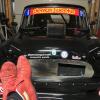Rear Radius Arm
#1

Posted 06 June 2020 - 02:09 PM
#2

Posted 07 June 2020 - 05:51 AM
As for when the arms are too far gone to redo it going to take some inspection work. I would say if the bushes have worn through to the actual radius arm then that one may be too far gone depending on the damage.
#3

Posted 07 June 2020 - 08:36 AM
Send it away for reconditioning (exchange) very few people have the correct kit to correctly ream the bush. A single hand reamer will not accurately work as they have no means of locating in the bearing to make sure of correct alignment.
#4

Posted 28 June 2020 - 08:13 PM
Edited by northernboy, 28 June 2020 - 08:26 PM.
#5

Posted 28 June 2020 - 09:17 PM
Thats an interesting piece of kit
#6

Posted 01 July 2020 - 07:04 PM
You may have to register on the Mk1 forum to read original post:-
Ultra-simple tools to remove rear arm bearing, bush & tube
http://mk1-forum.net...=28128&p=240858
Preparation:
Disassemble the arm to the point where you have the pivot shaft removed. It helps to remove as much excess grease that's hanging around, especially inside the bore behind the needle bearing. Just use your finger and a rag and get the bulk of the grease out.
Making the needle bearing removal tool:
1. Take a 12mm flat/thick washer (13mm ID X 24mm OD X 2.5mm thick, DIN125 or similar, 8.8 or 10.9)
2. Cut it in half so you end up with 2 half moons. Deburr the sharp edges where you cut.
3. On a flat surface, position them back together as if they'd never been cut, and tape them together using 1 piece of masking tape, on one side only. Trim any overhanging masking tape from the hole and the outside diameter. You should now have a "hinging" washer
Removing the needle bearing from the arm:
4. Put the washer on your middle finger so that it "tent's" over the end of your finger. You may drop it a few times until you get the hang of it but persevere.
5. Summon your inner proctologist and feed the tented washer into the needle bearing and just a little bit further until you can drop it onto the inner end of the needle bearing and have it unfold on the top of the bearing. Again it may take a few attempts but it won't be long till you can do it blindfolded. Here's a photo of the concept using a loose bearing to demonstrate.
6. Keep your assembly in a vertical position with the bushing end up and the needle bearing end down so the washer doesn't fall out of position. Feed a pivot shaft through the bushing end until it seats on the folding washer. You can now tap the needle bearing out without any drama or expensive special tools and the needle bearing will likely be undamaged. (If you're using a good shaft, make sure you protect the threads before hammering)
Making the Bushing removal tool: (material used is fairly common in US but I'm not sure how available it is elsewhere and may take some searching or substituting to find something suitable)
Cut a piece of 1/2" steel water or gas pipe to approx 12" length. (1/2" pipe is actually .840" OD). Ideally, use a pipe cutter to make the cut because the 1/2" pipe is slightly undersize for what is needed and a pipe cutter tends to displace material adjacent to the cut outward, kind of like knurling, which effectively enlarges the diameter several thousandth's and that will help the fit. It also insures you have a perpendicular cut. If that's not possible, you can hammer tap on the end of the pipe in a circular pattern several times which will tend to flare it slightly. The object is to have a snug slip fit with the inside diameter of the grease tube so you maximize the contact area with the bushing. If you go overboard just grab some sandpaper or a file and dress the diameter down a little. After many removals you may have to lightly dress the pipe end back to perfect size because it will tend to flare with use.
Removing Bushing:
Just slide the sized end of the pipe down the grease tube and beat on the other end to drive the bushing out. I've found it's better to use the heaviest sledge hammer, that way you won''t have to take big swings. Let the weight of the hammer do the work.
Making Grease tube removal tool: (The material I used is commonly available in the US and may take searching or substituting to find elsewhere)
Cut a piece of 3/4" EMT conduit (Electrical Mechanical Tubing) also known as Thinwall to approx 12" length.
Removing Metal Grease Tube:
In most cases the Grease tube will fall right out, but occasionally you'll find a tight one. The 3/4" EMT is just the right size to drive the tight one's out without damage.
Done!
PS I don't know if any of these removal tools work with the plastic style sleeve, because I've never done one.
Edited by mab01uk, 01 July 2020 - 07:11 PM.
0 user(s) are reading this topic
0 members, 0 guests, 0 anonymous users














